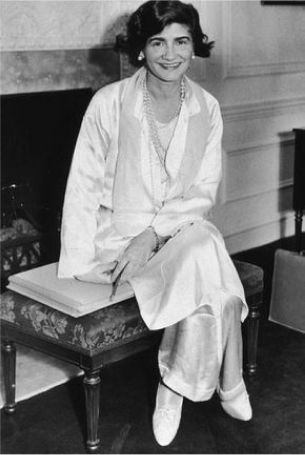
Coco
French fashion designer
Chanel
and businesswoman. The founder and namesake of the Chanel brand
She is the only fashion designer listed on Time magazine’s list of the 100 most influential people of the 20th century. A prolific fashion creator, Chanel extended her influence beyond couture clothing, realizing her aesthetic design in jewellery, handbags, and fragrance.
19 August 1883 – 10 January 1971 Saumur, France
Neiman Marcus Fashion Award, 1957
brand, she was credited in the post-World War I era with popularizing a sporty, casual chic as the feminine standard of style.
The founder and namesake of the Chanel
Chanel did not stiffen the material or use
shoulder pads, as was common in contemporary fashion. She cut the jackets on the straight grain, without adding bust darts. This allowed for quick and easy movement. For a higher level of comfort, the skirt had a grosgrain stay around the waist, instead of a belt.
First introduced in 1923, the Chanel tweed suit was designed for comfort and practicality. It consisted of a jacket and skirt in supple and light wool or mohair tweed, and a blouse and jacket lining in jersey or silk.
Suit
Chanel
More importantly, meticulous attention was placed on detail during fittings. Measurements were taken of a customer in a standing position with arms folded at shoulder height.
Chanel conducted tests with models, having them walk around, step up to a platform as if climbing stairs of an imaginary bus, and bend as if getting into a low-slung sports car.
Chanel wanted to make sure women could do all of these things while wearing her suit, without accidentally exposing parts of their body they wanted covered. Each client would have repeated adjustments until their suit was comfortable enough for them to perform daily activities with comfort and ease.
Little black
In 1926, the American edition of Vogue published an image of a Chanel little black dress with long sleeves, dubbing it the garçonne ('little boy' look).Vogue predicted that such a simple yet chic design would become a virtual uniform for women of taste, famously comparing its basic lines to the ubiquitous and no less widely accessible Ford automobile.
In 1912–1913, the actress Suzanne Orlandi was one of the first women to wear a Chanel little black dress, in velvet with a white collar. In 1920, Chanel herself vowed that, while observing an audience at the opera, she would dress all women in black.
dress
I imposed black; it's still going

strong today, for black wipes out everything else around
Her timing was of course, perfect. Because the dress was released in the Great Depression era, where simple and affordable was key. Later, during the war, textiles and fabrics were rationed, and the simple black dress remained the outfit of choice, as you could be elegant without breaking the bank.
black
Little
I imposed black; it's
still going strong today, for black wipes out everything else around
The
Initiator of a new, liberating and modern gesture, Gabrielle Chanel created a bag that she needed herself, an accessory which freed up the hands: the iconic bag of the House is born.
Coco Chanel designed her first bag in 1929, but like all the others available to upper-class women during the era, it was hand-carried and cumbersome.
In February 1955 she debuted the shoulder-carried version and changed handbag history. For the first time, it was acceptable for women of considerable social status to carry a bag on their shoulders.
Chanel bag
The shade of burgundy leather that has long been used to line the original flap bags (as well as some Classic Flaps) was chosen because of the uniforms worn by Coco and her fellow charges at the convent orphanage where she was raised.
Chanel’s signature quilting was purportedly inspired by the jackets worn by male stablehands that Coco was particularly fond of.
Also, Chanel’s most recent flap bag line, the Boy Bag, was named after and inspired by Coco’s longtime lover, polo player Boy Capel.
Even today, the classic design still follows the first partitions dictated by Gabrielle. The iconic bag is part of an heritage that is transmitted from mother to daughter.
Fashion becomes

unfashionable, style never

bag
Chanel

This longread is a fully non-commercial and is not used for any commercial purposes. All the images used for this project development belong to their owners and are over their rights.
2022 © All rigths reserved.

